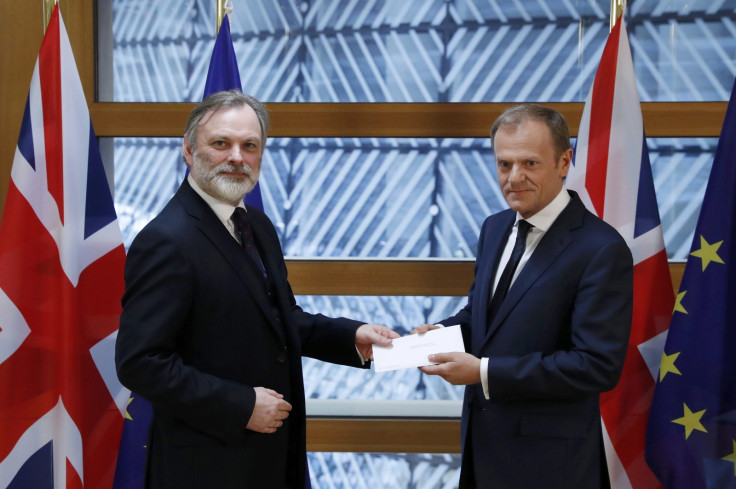FX Focus: Pound surges as Brexit process begins
Pound gains against euro and dollar after Theresa May triggers Article 50 to begin Brexit.
The pound surged on Wednesday (29 March), as Theresa May triggered Article 50 of the Lisbon Treaty, formally beginning the process of taking Britain out of the European Union after a 44-year membership.
Having fallen to as low as $1.2378 earlier in the session, the pound strengthened to a daily high of $1.2469 shortly after the Prime Minister confirmed Britain would leave the 28-country union. However, that remained over a cent lower than the two-month high it hit against the US dollar on Monday.
Meanwhile, sterling jumped 0.89% against the euro, trading at €1.1585 and seemingly defying doom and gloom predictions for the time being.
Shortly before 12.30pm, British ambassador Sir Tim Barrow handed a letter to President of the European Council Donald Tusk, which was signed and sealed by May last night, announcing the UK's intentions to leave the EU on 30 March 2019.
Over the next two years there will be fraught negotiations between Britain and the remaining 27 states as they attempt to hammer out a new formal relationship, avoiding the metaphorical "cliff edge Brexit".
May told fellow MPs: "This is an historic moment from which there can be no turning back. Britain is leaving the European Union. We're going to make our own decisions and our own laws, we're going to take control of the things that matter most to us."
The PM also added Britain will seek to retain a "deep and special" partnership with the EU.
Despite the pound's positive response in the immediate aftermath of the PM's speech, analysts warned the currency remained subject to bouts of volatility. "A truly hard Brexit has not been priced into sterling," said ETX Capital analyst Neil Wilson. "We could see it move lower still if negotiations take a sour turn - $1.10 is feasible.
"The old hard vs soft Brexit debate is once again central to expectations for the pound. Sterling will rise on any indications of a softer Brexit and fall on any signs it's going to be hard. If we head towards a cliff-edge then it could collapse."

FXTM research analyst Lukman Otunuga, warned that while sterling has traded higher following the official triggering of Article 50, hard Brexit fears remained rife with the EU's demand for a £50bn bill already adding to the "horrible cocktail of potential complications" in the early stages of the negotiations.
"While most have suggested that Brexit has already been priced in, markets may be in for a rude awakening in the future, especially if Sterling finds itself exposed to further downside shocks amid the rising uncertainty," he said.
Fawad Razaqzada, market analyst, at Forex.com said it was logical to think that the pound could remain under pressure in the long-term, particularly given Scotland's future in the UK is becoming increasingly questionable.
However, he added, in the short-term, sterling could be on the verge of a "massive" short covering rally. "It is unlikely that governments within the EU would seek to punish the UK just because its people have decided that it should leave the union," he explained. "Instead, the EU will likely hold constructive talks with the UK government to find a deal that would benefit both regions."
Elsewhere, the dollar regained ground as worries over Donald Trump's policies were offset the positive impact of a report released on Tuesday, which showed consumer confidence rose to the highest level in 16 years in March.
The greenback rose 0.60% and 0.40% against the euro and the Swiss Franc respectively, trading at 0.9301 euro cents and CHF0.9969 respectively, but declined 0.31% against the yen to ¥110.80 and was largely flat against its Canadian and Australian counterparts.
© Copyright IBTimes 2024. All rights reserved.






